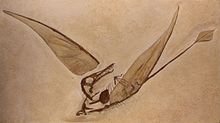Rhamphorhynchus (pterosaur)
|
Rhamphorhynchus Temporal range: Late Jurassic, 150.8–148.5 Ma |
|
|---|---|
 |
|
| Cast of the first specimen found with wing membranes, Musée de sciences naturelles de Bruxelles | |
| Scientific classification | |
| Kingdom: | Animalia |
| Phylum: | Chordata |
| Class: | Reptilia |
| Order: | †Pterosauria |
| Family: | †Rhamphorhynchidae |
| Subfamily: | †Rhamphorhynchinae |
| Genus: |
†Rhamphorhynchus Meyer, 1846 |
| Type species | |
|
†Pterodactylus longicaudus Münster, 1839 |
|
| Species | |
|
|
| Synonyms | |
|
Genus synonymy
Species synonymy
|
|
Rhamphorhynchus (/ˌræmfəˈrɪŋkəs, -foʊ-/, "beak snout") is a genus of long-tailed pterosaurs in the Jurassic period. Less specialized than contemporary, short-tailed pterodactyloid pterosaurs such as Pterodactylus, it had a long tail, stiffened with ligaments, which ended in a characteristic diamond-shaped vane. The jaws of Rhamphorhynchus housed needle-like teeth, which were angled forward, with a curved, sharp, beak-like tip lacking teeth, indicating a diet mainly of fish; indeed, fish and cephalopod remains are frequently found in Rhamphorhynchus stomachal contents, as well as coprolites.
Although fragmentary fossil remains possibly belonging to Rhamphorhynchus have been found in England, Tanzania, and Spain, the best preserved specimens come from the Solnhofen limestone of Bavaria, Germany. Many of these fossils preserve not only the bones but impressions of soft tissues, such as wing membranes. Scattered teeth believed to belong to Rhamphorhynchus have been found in Portugal as well.
The largest known specimen of Rhamphorhynchus muensteri (catalog number BMNH 37002) measures 1.26 meters (4.1 ft) long with a wingspan of 1.81 m (5.9 ft).
...
Wikipedia
